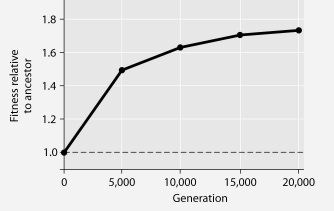Multiple Choice
The following questions refer to Figure 27.1.
In this eight-year experiment, 12 populations of E. coli, each begun from a single cell, were grown in low-glucose conditions for 20,000 generations. Each culture was introduced to fresh growth medium every 24 hours. Occasionally, samples were removed from the populations, and their fitness in low-glucose conditions was tested against that of members sampled from the ancestral (common ancestor) E. coli population.

Figure 27.1
-If the experimental population of E. coli lacks an F factor or F plasmid, and if bacteriophages are excluded from the bacterial cultures, then which of these is (are) means by which beneficial mutations might be transmitted horizontally to other E. coli cells?
A) via sex pili
B) via transduction
C) via conjugation
D) via transformation
E) Two of the responses above are correct.
Correct Answer:

Verified
Correct Answer:
Verified
Q58: The following table depicts characteristics of five
Q59: Bacteria perform each of the following ecological
Q60: Match the numbered terms to the description
Q61: Hershey and Chase performed an elegant experiment
Q62: The following table depicts characteristics of five
Q64: Prokaryotic ribosomes differ from those present in
Q65: Which of the following statements is not
Q66: Which statement about the genomes of prokaryotes
Q67: Mycoplasmas are bacteria that lack cell walls.
Q68: The following table depicts characteristics of five